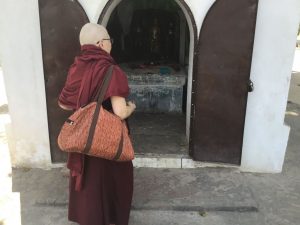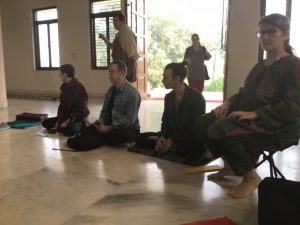Sankisa, where the Buddha descended from heaven
Yesterday we had a rather long trip in a mini bus. We departed from hectic Newhi Delhi at 9 am. I had an interesting conversation with a fellow traveller and read in my book “In the Buddha’s Words” by Bhikkhu Bodhi. At 8 pm we arrived in Sankisa, a very small town in the middle of nowhere. Thank God we were away from the heavy pollution in Delhi. Even 6 s drive out of Delhi you can look straight at the sun without blinking, still that is better than Delhi because there you don’t see the sun at all.
The hotel is nice and clean and simple, probably mainly built for pilgrims. At the dinner table we see several groups from different parts of the world. By the way, the food in India is fantastic. You have to be careful about your hygiene, but apart from that I am enjoying my meals.
Today we went to the old stupa at the place where it is said that the Buddha descende from the Tushita heaven after teaching his deceased mother, Maya. She died 5 days after Gautama was born. This was such good merit for her that after her demise she was reborn as Myadevi among the gods in the Tushita heaven. The Buddha felt an obligation to repay her kindness by teaching her the intricacies of the mind and of consciousness. So while he was put at Sankisa during the rain season at the age of 42, he ascended a miraculous staircase that brought him to the heaven. There he taught Mayadevi and the other gods and celestial beings the secrets of consciousness. But he still had to eat, so every day he descended in the morning to go on his alms round and to eat before noon. While he was down on earth he instructed his most gifted desciple Shariputra. He gave him a synopsis of what he taught the day before to the gods.

Shariputra later compiled what he had learned and composed the first version of what later became to be known as the Abhidhamma. A analytical treatise on how our mind composes our experiences into reality as we experience it. As far as I know this is the only book that explains consiouness in great detail. It is considered one of the three most sacred compilations of texts in Buddhism. They are called the Tipitaka (or Tripitaka in Sanscrit). It means the three baskets, the first one is compiled of the Sutras (the Suttaka). The second contains the rules for living in the community (Sangha) of disciples, called the Vinaya-taka. The third is the Abbhidhamma-taka. A description explaining how reality is built up from the smallest to the biggest, both in size and in time. And how we experience it. After studying it one is fully aware of the complete interconnection of all phenomena both in our mind as well as out in the world.

The Theravadin followers of Myanmar are really very specialized in this. They erected a temple close to the old stupa to commemorate their connection with this place. We’ll be going there later to read the Anapanisathi Sutta and to meditate.
